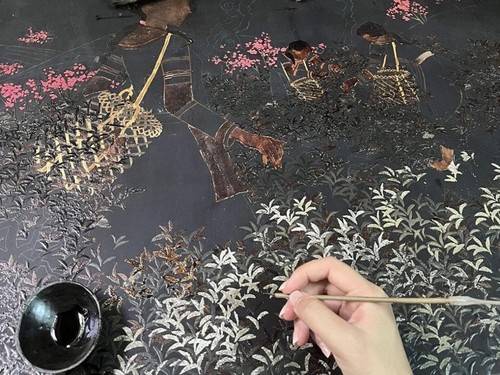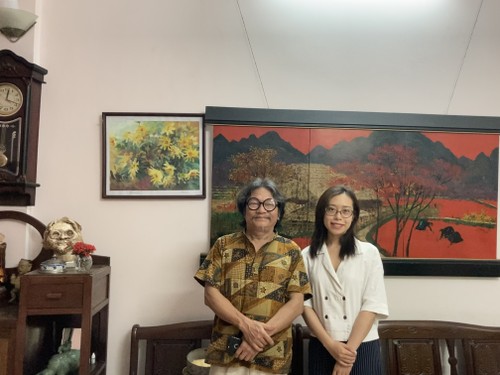“Here is a painting of a tea hill. For this hill, I will need to draw the leaves using 3 layers of different shades. The technique of traditional Vietnamese lacquer painting requires the artist to paint from front to back, details first and landscape later. This tea hill is in the front, so I draw it first, then apply the background.”
Minh Phuong described to VOV the painting she is working on and discussed some basic techniques used to create a lacquer painting in the traditional Vietnamese way.
Son Mai uses a toxic resin harvested from wax trees grown in Phu Tho province mixed with colors derived from natural materials like gold, silver, eggshells, and mother of pearl. The artist has to go through a meticulous process that may take months or even years. It involves drawing an outline, painting layers of different colors, and adding embellishments. The most crucial step is the final sanding and polishing.
The time and skills required and rare natural materials used give Vietnamese lacquer paintings a smooth surface, lasting shine, and a uniqueness that has been recognized in the world since the early 20s.
 Nguyen Minh Phuong works on a lacquer painting. Nguyen Minh Phuong works on a lacquer painting. |
However, Son Mai is not a craft for all artists. And it’s beginning to fade. With almost 50 years of dedication to Son Mai, artist and lecturer Pham Chinh Trung, Minh Phuong’s teacher, adjusted that Son Mai has become less popular among art students, who prefer painting genres that involve lower material costs and make it easier to earn a living.
“As a teacher, I want to keep as many people creating traditional Son Mai as possible. If it is lost, it will be a tragedy because it took the efforts of many generations of painters to build and maintain the Vietnamese lacquer brand,” said Trung.
Minh Phuong has only been studying and making lacquer paintings for 4 years. She joined teacher Trung’s private class in 2013 with two friends to learn general drawing to support her job as a graphic designer. At that time, she did not even know what Son Mai was.
“There I had the opportunity to get an insight into lacquer painting and learn how Son Mai is created. The more I learned about it, the more I realized how precious and beautiful it is,” said Phuong
A core fact of lacquer is that the artist, even the most experienced does not have 100% control of the colors. Phuong says she loves the fact this craft always gives her a sense of anticipation and surprise in the final product.
She has a tremendous challenge in learning how to use the different materials and discovered she has an allergy to the toxic resin. Phuong once had to shut herself indoors for a whole month and use star fruit to treat her swollen skin after coming in contact with the lacquer.
“Teacher Trung advised me to give up because my allergy makes me unsuited to this career. But I was stubborn enough that after recovering from my allergy, I asked him to give me another chance. I got sores again several times but not as severely as the first time. I found out that as long as I’m not in direct contact with the lacquer, I’m fine, so I continue to study with great care,” said Phuong.
These problems failed to discourage the young artist and instead motivated her even more. Her efforts paid dividends with her first painting.
“It was so great. I ended up painting a red background and could not see anything but a red board. On sanding day, I was surprised to see leaves, the first things I had drawn, appeared after the first sanding. Then the bamboo was slowly revealed. It was like turning upside down the whole drawing process. Very surprising indeed,” said Phuong.
Phuong says she was fortunate enough to sell her first painting favorably. Out of curiosity, she had uploaded her paintings to an art forum to see how people would react to Son Mai, and whether her style would be welcomed or not.
“When a buyer contacted me, I was very surprised. I was not ready to sell any paintings at that time, but when I consulted with my teacher, he encouraged me to sell it to cover the material costs of making more paintings,” said Phuong.
 Nguyen Minh Phuong (R) and her teacher Pham Chinh Trung. Nguyen Minh Phuong (R) and her teacher Pham Chinh Trung. |
Teacher Trung said, "Phuong worked very hard despite any difficulties or bad weather. Artists who still pursue Son Mai are very passionate people. They have to do other jobs to cover the expense of making lacquer paintings.”
Phuong has worked various jobs to support her Son Mai career, including working as a graphic designer and publisher’s assistant. She believes that with perseverance and effort, she can continue to follow her passion for this unique Vietnamese art form.
“I've always wanted to make Son Mai paintings. Not many young people are willing to learn and pursue this art genre now. If I don't do it, that will be one person less.”